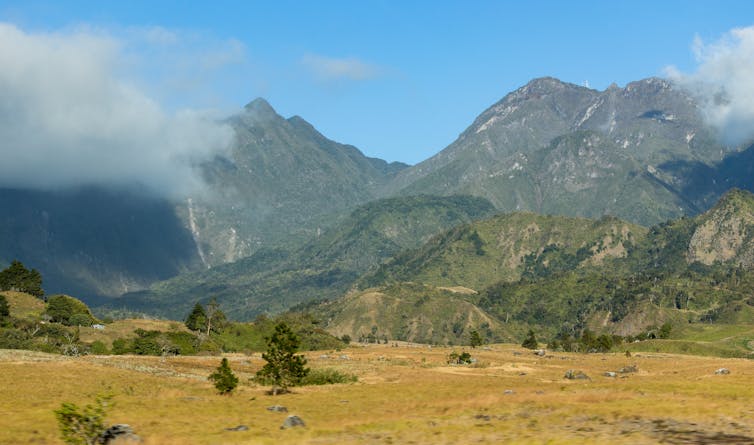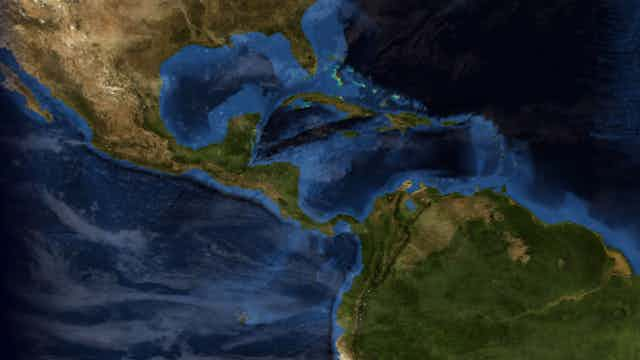Panama has been in the news for other reasons recently, but paleoclimatologists have long known of its significance. In fact, the formation of this thin strip of land between North and South America may be one of the key events in Earth’s history.
Today, the Panama Canal is one of the world’s most important shipping lanes, allowing large ships to go straight between the Atlantic and Pacific Oceans while avoiding longer and often more dangerous routes around the tip of South America.
But this isn’t the first time there has been an equatorial connection between our two largest oceans. More than 20m years ago, Panama and much of Central America was under water or, more accurately, much of this land mass was yet to form, and water flowed freely between these two climatically important ocean basins.
Once you zoom out to geological timescales of millions of years, it becomes apparent that plate tectonics – continents drifting around the Earth’s surface – have a huge impact on the climate. The position of continents naturally affects the shape and size of the oceans, and crucially, the currents that flow within them that transport energy (in the form of heat) to different parts of the globe.
In this case, the shallowing and eventual closure of the Panama “gateway” and creation of the Isthmus of Panama, where both continents become connected by land, strengthened what we call the “Atlantic Meridional Overturning Circulation”, a current that transports warm equatorial waters north and is responsible for Europe’s mild winters. This played a crucial role in shaping our modern climate system.
How Panama closed
None of this happened overnight. What’s now Panama lies on the boundaries of the South and North American, Caribbean and Cocos plates, and collisions between these huge masses around 23-25m years ago led to rises in the seafloor and the formation of underwater volcanoes. Over time, these eventually emerged above the water line.

By 7m to 11m years ago, the volcanoes had grown, and the sea had become shallow enough that deep water exchange between the Pacific and Atlantic is thought to have ceased, leading to a reorganisation of oceanic currents. Finally, around 3m years ago, a land bridge emerged, connecting both North and South America. Or so the story goes …
Why timing matters
Establishing the timeline is crucial in piecing together the Panama gateway’s climatic role, yet new evidence suggests the closure was earlier than previously thought.
Fossils of both terrestrial and marine species suggest closure may now even date back to around 20m years ago, when there were periods of land chains above sea level, although likely not fully connected. This is 17m years earlier than first suggested. Although land species were moving between the continents as far back as around 20m years ago, it wasn’t significant until 6m years ago, implying that there must have still been inhibitors to mass migration of species between these land masses before then.
The recent removal of sediment for the new expansion of the Panama Canal unearthed 20m year old fossilised trees, adding further weight to an earlier closure hypothesis. The same study also suggests that the isthmus may have even formed an uninterrupted chain of land between the Late Eocene (20m-30m years ago) to the Late Miocene (11m-5m years ago), further compounding the long and complex history of this climate-altering event.
Changing oceans, changing climates
The shoaling and eventual closure of the Panama gateway was a key reason for glaciation in the northern hemisphere. As winds in the atmosphere often respond to what is occurring in the ocean below, changes in ocean circulation that developed with the shallowing and closure of the Panama seaway led to warm, moist winds blowing northwards. This fresh water held in the atmosphere was deposited at high latitudes where glaciers and ice sheets could form.
Analysis of geological data has shown that despite an open Panama gateway (no isthmus) the strength of the Atlantic Meridional Ocean Circulation was unaffected during the Pliocene (around 2-5m years ago). This casts doubt on the key importance of complete isolation between the Atlantic and Pacific.
Indeed, conventional geologic theory on the role of the Panama seaway is being challenged. Some argue that greater heat transport towards the poles (in the form of a stronger gulf stream) may have actually hindered ice growth and delayed glaciation in the northern hemisphere. One climate modelling study suggested though that the increased moisture transport outweighs the increase in temperature, supporting the hypothesis that the closure intensified northern hemisphere glaciations through changes in oceanic circulation.
The closure of Panama, and the end of deep water currents flowing between oceans, is not solely responsible for kicking off the ice ages. Other primary factors include decreasing amounts of carbon dioxide in the atmosphere, changes in the Earth’s axis, and long-term “wobbles” which meant the poles received less sun.
However, we can say the transformation of Panama from seaway to isthmus played a crucial role in shaping our present day climate. It’s a great example of how geography and climate are linked: one small strip of newly-created land changed the planet forever.

